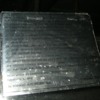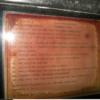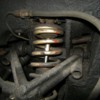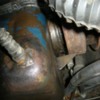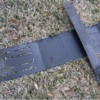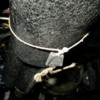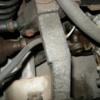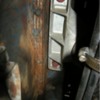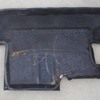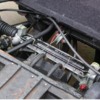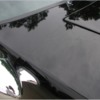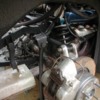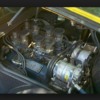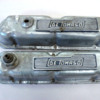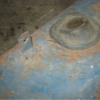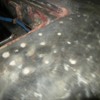DO NOT unbolt them from the spine as that will result in a lot of work to re align them later.
Simply lift one side and remove the two 13 mm bolts from the spine on that side. Put the cover down with something to prevent it from locking in place.
Do the same for the other side and with four people lift the covers, joined by the spine and put the assembled unit down in a prepared safe place.
Dick Ruzzin
Do not close them completely, always allow a little water flow or the hoses will dry out and split.
Dick Ruzzin
quote:Originally posted by Mark Charlton:
Yes, the spine is removable after the wings are removed.
Your 'goose is outrageous. I can't believe how original it was when you found it.
quote:Originally posted by PanteraDoug:quote:Originally posted by Mark Charlton:
Yes, the spine is removable after the wings are removed.
Your 'goose is outrageous. I can't believe how original it was when you found it.
I think you mean Lee's car. It has the oft-lost header shields, Air Filter assembly AND even the paper air intake tubes. I sure would like to see a detailed gallery of photos of the car because it does look really original and complete.
Mark
Mark, I have more ![]()
As long as nobody minds, let me post a few more of interest...
Here is something you may have never seen; this sticker was applied on the bulkhead glass, it is unique per car (with the serial number and signed...here by "Alberto," so seemingly applied in Italy). Btw, I've tried to track the font of the typewriter to Olivetti, still no luck ![]()
Attachments
quote:Originally posted by Mark Charlton:quote:Originally posted by PanteraDoug:quote:Originally posted by Mark Charlton:
Yes, the spine is removable after the wings are removed.
Your 'goose is outrageous. I can't believe how original it was when you found it.
I think you mean Lee's car. It has the oft-lost header shields, Air Filter assembly AND even the paper air intake tubes. I sure would like to see a detailed gallery of photos of the car because it does look really original and complete.
Mark
I meant your yellow car. I was looking at the pictures of it on your web page. It just didn't have the original induction and valve covers. Other then that, it's pretty original. Never saw a Mangust radio before.
If the rest of Lee's car is as original as the induction then, yes it is outrageous too?
So far Mangustas are like Cobras. No one would ever let me sit behind the wheel.
Must be that I grow horns and fangs when I look at them?
I still don't know if I'll fit in a 'goose?
At 6'2", I kinda doubt it.
Seal on the steering column...Someday this will be worth points at Concours...
(update October 2024---8MA840 is the only other Goose I've seen that has this still on the steering column. And still, nobody can explain why it was there (some guesses that it was a tax emblem, but I think this is wrong...Miura guys have this, they can't explain it either...!)
Attachments
red inspection marks just about everywhere, here on the motor mount brackets. Note yellow insert in the nylocks on the rear suspension--I swear I think other places had red insert nylock. good luck finding those... (ps, red insert Nylocks were probably supplied by ESNA. Yellow insert nyloc nuts were used by Ferrari and are slightly easier to find, see Abbot Interfast).
(BTW, "torque seal" Marking between nut and bolt is otherwise common to detect rotation, but is not used on the Goose---only marking on the top of the bolt head).
Attachments
Attachments
Those are the same brake calipers as the Cobra race calipers, aluminum or is that silver cad on iron?
What are the tubes I'm looking at going to the steering rack? Is this a power rack?
There must be 100# of undercoating on the chassis? Was detomaso in the paving business too?
The amount of work to do on a basket case would keep one of these cars off the road for 20 years? Yikes! This is a very labor intensive car.
It would cost a couple of hundred thousand to build it today. It cost $11,000 + back then with paying the workers $7 an hour and the quality of workmanship is very, very high.
This is not Detroit production line work. Amazing. Well maybe not on the dimple welds on the front fenders though? I see them. I wouldn't be happy with that as the first new buyer.
Thanks for posting, Enjoying seeing it naked.
Doug, the calipers here are aluminum, 2 piston fronts. This changed just a few cars later to iron, 3 piston Girling 17/3.
The tubes wrapping close to the chassis are water lines for the heater, the rack is unassisted (a Renault piece, I understand)--Lee
On 8MA510 (a verified 1967), the engine was a hi-po 289 with the extra balancer weight visible behind the harmonic balencer, which is the easiest way I know to tell, as long as you don't mind getting dirty. The ZF in that car had exposed shift linkage going into the transmission, which Lloyd Butfoy said was the same as original GT-40s. In other words, the rectangular aluminum box normally housing the ZF shift linkage was not there, nor were it's mounting holes.
I've also seen big aluminum 2-piston Girlings on both ends of a couple of Mangustas; you sometimes need a magnet to verify the material. 'Geese with such is 8MA 760 (in England) and 8MA 712 (now in Germany). These I think were the desirable big-block Cobra brakes in most cases due to the lightness. An odd fact: virtually ALL European brake calipers that I've cheacked including the aluminum and iron Girlings, Porsche & others, all use nickel-plated mild steel pistons (which are magnetic). And since plating is never a continuous film, water in old fluid will penetrate it and pit it just like an old bumper. Finding NOS pistons for 50-yr-old calipers is a daunting chore; I had to make a set on the lathe (of 312 stainless). So change that brake fluid yearly!
Finally, one Swedish Mangusta has aluminum bearing side-plates on it's ZF, which was also a stock part for very early small-block GT-40s, according to Lloyd. I have a pair of those that I run on our Pantera's dash-2 ZF for the 6 lbs of lightness apiece.
quote:Originally posted by Bosswrench:
A few comments from a non-owner: I'm 6'2"/190 lbs and have semi-successfully driven Mangusta 8MA 632 some 50 or so miles. But our size human gets folded up pretty good in one of these cars. During the stint, I hit some whoop-de-dos at about 90 and my left knee managed to turn off the ignition key... the owner was in the passenger seat and we both thought it was an engine failure! I think I'd move that part if I still owned one.
The Pantera is child's play by comparison to tailor the fit on.
I don't have to worry too much though about owning a Mangusta? All I could afford would be a basket case and it would take me 20 years to get it all together?
quote:Originally posted by Bosswrench:
On 8MA510 (a verified 1967), the engine was a hi-po 289 with the extra balancer weight visible behind the harmonic balancer, .
Boss, Any pics to share on 8MA510, Not in any of the registries.
Denis
quote:Originally posted by Bosswrench:
Finally, one Swedish Mangusta has aluminum bearing side-plates on it's ZF, which was also a stock part for very early small-block GT-40s, according to Lloyd. I have a pair of those that I run on our Pantera's dash-2 ZF for the 6 lbs of lightness apiece.
That looks like an aluminum side plate to me in the picture above?
On aluminum ZF sideplates, they interchange & appear identical to aluminum-painted cast iron ones, so it takes a magnet to tell for sure. Mine are designed to fit the sand-cast 2-hole bellhousing with the dog-leg-lugs that tied into lugs on the bellhousing with 4 extra bolts. I don't use the extra lugs. Story is, early ZFs had all-aluminum side & end plates, but when Ford was testing the ZF with 427s for Mark 2 GT-40s & Le Mans, the cases 'heated up' under long, hard 200 mph runs with big-block torque; the aluminum side plates expanded, reducing side bearing pre-loads diff failure. So to counteracts this potential racing problem, ZF changed the side and end plates to stiffer cast iron, in the same design. Ford never trusted ZF and ultimately used other transaxles in the Mk 2s anyway. Later, ZF dropped the troublesome dog-leg-lugs from the side plates.
On the street behind a 351-C, aluminum side and end plates cause zero problems & remove 15 lbs total wt. In 2-3 hr runs at way-non-legal highway speeds, our ZF lube barely gets to 180F- almost enough to purge condensation out of the cases but not near enough for a diff cooler.
quote:Originally posted by PanTTera:
Although converted to (or supplied with?) Webers,this web photo of a "67 Mangusta" engine clearly shows that right valve cover throttle return spring tab.
It has no air pump showing? '67 Shelby's intended for sale in California already had them on 4 speed cars. I presume that all other Ford products did too?
The other 49 state cars did not to my knowledge. All '68 4 speed cars did have the air pump with the air port injectors into the exhaust ports.
Do you know anything more about the car this picture came from?
Do Mangustas have a warranty tag attached to them like the Panteras do that show the date of manufacture?
Here...............
http://www.conceptcarz.com/veh...Tomaso-Mangusta.aspx
quote:Originally posted by PanTTera:
"more about the car this picture came from"
Here...............
http://www.conceptcarz.com/veh...Tomaso-Mangusta.aspx
Wow. That's a confusing article.
There is no mention of a serial numer but I think it's a '70 or '71 with the pop up lights, it has a Ford engine in it, not a Chevy like the article says, and those are IDF Webers, not IDA'a.
The IDF's are something that happened in the last decade for these engines. Not in '67.
Interesting find though. Thanks for posting.
I own that car.
DICK RUZZIN
quote:Originally posted by LeeA:
...it cannot be seen in the photo, but I swore someone had taken a ball-peen hammer and dimpled the area of the fenders here...
Lee thanks for the excellent photos, really appreciate a chance to see original details on 1046. Awesome machine!
Re. dimpling, I'd heard about it appearing on some original cars but never actually witnessed this. Just for kicks here is a photo of the chassis understructure in the top fender area. I believe the circled sheetmetal fold was originally welded to the front fender in a few spots, creating small dimples with time. (Note that ~2" of the fold on my car is missing, probably cut off when the original fender was removed.) I don't see any traces now of previous welds but they must have been there originally.
Attachments
My car has a functioning heater, actuated with control next to e-brake
Funny coincidence going thru pics today; I purchased a set of valve covers with castings last fall and there is a small tab as posted by LeeA. Now we need to know if that tab is on the driver's side or pass side.
Attachments
quote:Originally posted by Denis C:
I do not have the heater valve in the engine compartiment; the in car heater has 2 levers on the left and a "choke style" pull-off on the right.
Funny coincidence going thru pics today; I purchased a set of valve covers with castings last fall and there is a small tab as posted by LeeA. Now we need to know if that tab is on the driver's side or pass side.
The grommets in the valve covers would tend to indicate that the cover with the tab goes on the passenger side? Look at the first picture Lee posted. You can see the grommet.
The large oil cap is more to the left on its valve cover than the pcv opening is for its valve cover. The bottom valve cover in the photo has the large oil cap, to the left, no tab, and is for the driver's side.


